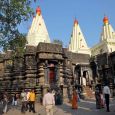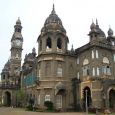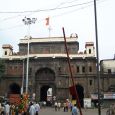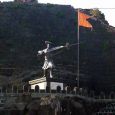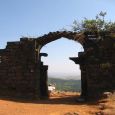Kolhapur
Advertisement
By Air
The city has an airport near Ujlaiwadi, 13 km from the city centre. The airport runway was declared safe by Airport Authority on 02-03-2011. Takeoffs will start soon as per the convenience of Mumbai Airport.
By Train
Kolhapur is connected to number of cities across India. There are direct trains from Kolhapur towards Mumbai, Pune, Nagpur, Bangalore, Delhi, Hyderabad, Tirupati, Ahmedabad, Dhanbad, Solapur. Kolhapur railway station is known as Chatrapati Shahu Maharaj Terminus and it is a part of Central Railway. There are local shuttle trains running from Kolhapur-Sangli, kolhapur-Miraj.
By Road
Kolhapur is connected to Mumbai to the north and Bangalore to the south by National Highway 4 which is further extended to Chennai.It is one of the primary destinations on this highway. Kolhapur has state transport bus stands namely Central Bus Stand (CBS), Rankala & Sambhajinagar. Kolhapur Municipal Transport buses covers almost all routes inside the city and they are available after every 15 minutes towards the main areas and after every 30 minutes towards suburban areas. Auto rickshaws in kolhapur are very famous for their interiors and comfortable seating arrangements. They are also one of the popular mode of transports within the city.
Mahalakshmi Temple
The Shri Mahalakshmi Temple of Kolhapur in Maharashtra, India, is one of the Shakti Peethas listed in various puranas of Hinduism. According to these writings, a Shakti Peetha is a place associated with Shakti, the goddess of power. The Kolhapur Shakti Peetha is of special religious significance being one of the six places where it is believed that one can either obtain salvation from desires or have them fulfilled. The temple takes its name from Mahalakshmi, the consort of Vishnu, and it is believed that the divine couple reside in the area.
The temple belongs architecturally to the Kannada Chalukya empire and may have been first built in circa 700 AD. Mounted on a stone platform, the image of the four armed and crowned goddess is made of gemstone and weighs about 40 kilograms. The image of Mahalakshmi carved in black stone is 3 feet in height. The Shri Yantra is carved on one of the walls in the temple. A stone lion, the vahana of the goddess, stands behind the statue. The crown contains an image of the Sheshnag the serpent of Vishnu. In Her four hands, the deity of Mahalakshmi holds objects of symbolic value. The lower right hand holds a mhalunga (a citrus fruit), in the upper right, a large mace (kaumodaki) with its head touching the ground, in the upper left a shield (khetaka), and in the lower left, a bowl (panpatra). Unlike most Hindu sacred images, which face north or east, the image of this deity looks west (Pashchim). There is a small open window on the western wall, through which the light of the setting sun falls on the face of the image for three days around the 21st of each March and September. There are a number of other shrines in the courtyard to the Navagrahas, Surya, Mahishasuramardini, Vitthal-Rakhmai, Shiva, Vishnu, Tulja Bhavani and others. Some of these images date back to the 11th century, while some are of recent origin. Also located in the courtyard is the temple tank Manikarnika Kund, on whose bank is a shrine to Visweshwar Mahadev.
Vishalgad Fort
Vishalgad was one of the important forts of Shivaji and Maratha Empire. The name ‘Vishalgad’ meaning grand fort in Marathi, was given by Shivaji after annexing it for the Maratha Empire in 1659.The fort is about 1130 meters that is 3630 feet.The fort is situated in Maharashtra, India. It is 76 kilometers North-West of Kolhapur, 60 kilometers north-west of Panhala fort and 18 kilometers south of Kolhapur Ratnagiri road. It is situated on the hills that divide the region into two parts viz Amba ghat and Anaskura ghat. Since it is placed on the border of the hilly portion of Sahyadri ranges and the konkan region, it got great political significance in the historical times. It was regarded as a 'Watch tower' for both the region.
Panhala Fort
Panhala Fort also known as Panhalgad, Pahalla and Panalla is located in Panhala, 20 kilometres northwest of Kolhapur in Maharashtra, India. It is strategically located looking over a pass in the Sahyadri mountain range which was a major trade route from Bijapur in the interior of Maharashtra to the coastal areas.Due to its strategic location, it was the centre of several skirmishes in the Deccan involving the Marathas, the Mughals and the British East India Company, the most notable being the Battle of Pavan Khind. Here, the queen regent of Kolhapur, Tarabai, spent her formative years. Several parts of the fort and the structures within are still intact.
Siddhagiri Gramjivan Wax Museum
Siddhagiri Gramjivan Wax Museum at Kaneri near Kolhapur, Maharashtra is a unique wax museum, probably the only one of its kind in India. The museum is called ‘Siddhagiri Gramjivan (Village life) Museum’. This unique project is the only of its kind in India and situated at Shri Kshetra Siddhagiri Math. Many people know about Kaneri Math but very few know about this museum.This museum showcases different aspects of Gramjivan (village life).‘Gram’ means ‘village’ and ‘jivan’ means ‘life’ in Marathi language.This initiative was dream project of Mahatma Gandhi, visually and symbolically created through the vision and efforts of Siddhagiri Gurukul Foundation Trust. The history of self-sufficient village life before invasion of Mughals in Maharshtra is depicted here in the form of cement sculptures. Each sculpture is life-like and has a multi dimensional effect and lifestyle theme. There were 12 Alutedars (12 main profession-based castes i.e. Professions performed from generation to generations by families) and 18 Balutedars, who provided equipments to all villagers to fulfill their day-to-day necessities (domestic as well as professional).
The museum is spread over 7 acres area and has almost 80 scenes which showcase more than 300 statues. The surrounding countryside is beautiful and is surrounded with lush greenery. Every aspect of village life has been depicted in this museum. It is a perfect blend of fact, powerful imagination and enormous hard work in getting the life-like expressions of the whole village.
Shree Chhatrapati Shahu Museum
Shree Chhatrapati Shahu Museum is a museum in Kolhapur town in Indian state of Maharashtra. The museum is housed in the new palace building completed in 1881.The costumes, weapons, games, jewellery, embroidery and paraphernalia such as silver elephant saddles and the interesting collections from the possessions of Maharaja Shahaji Chhatrapati like guns, trophies and clothes are housed in the museum.
Bhavani Mandap
Bhavani Mandap is a historical building situated in the walled city center of Kolhapur in southern Maharashtra, India. It is located near the famous and mammoth Mahalaxmi Temple on the west.Although smaller in size than Mahalaxmi temple, Bhavani Mandap holds equal importance to the citizens and pilgrims all over the country. It is the temple of goddess Tulja Bhavani (also known as Bhavani) who according to mythology is a guest in her elder sister Mahalaxmi's city Kolhapur.
Bhavani Mandap was an important meeting venue in yesteryears. It housed the offices of various court officials and was centre of many celebrations. It also saw a famous murder in the central courtyard. The place has the nostalgic charm and typical architecture of the British Raj bringing back memories of the rich princely state Kolhapur used to be.
Information not available


